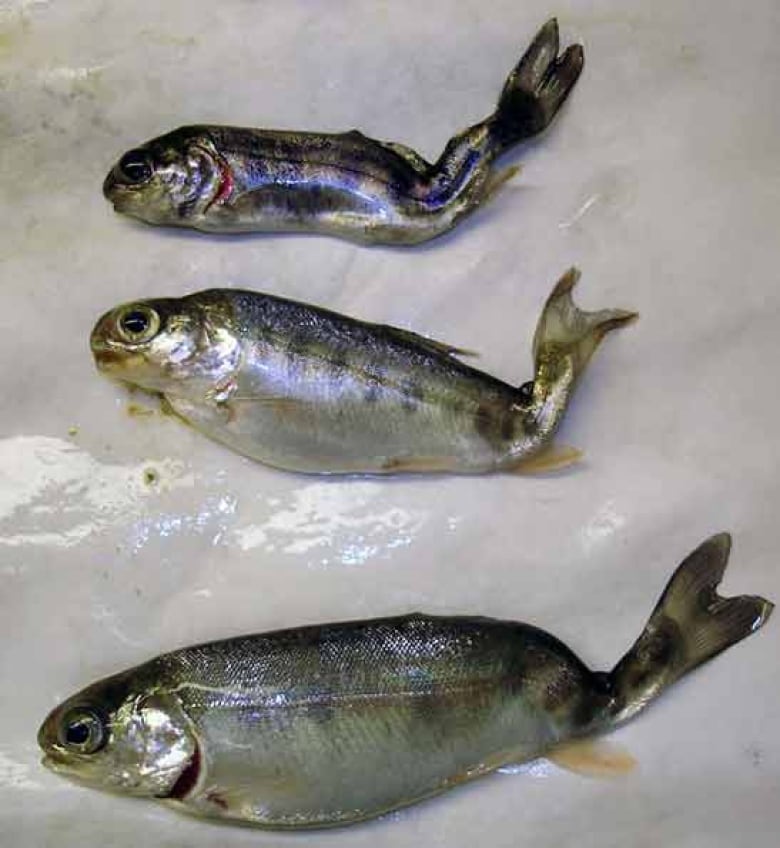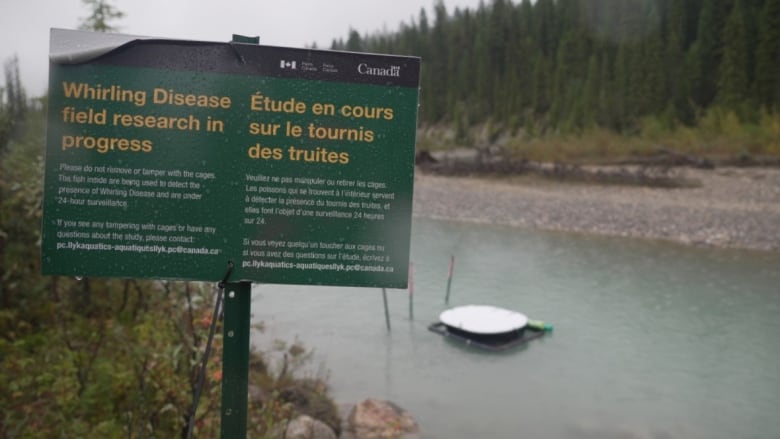
Marie Veillard stands at the edge of the vast Kootenay River in Kootenay National Park. She’s checking on a group of fry, baby fish she’s been looking after for a few weeks now.
They’re happy to see her, aggressively swimming for the food she’s feeding them in their cage on the river — part of a Parks Canada monitoring program to detect early signs of the disease.
As the rain falls on the gin-clear water, Veillard, a Parks Canada aquatic invasive species expert, remembers the moment she saw a group of fry chaotically swirling around her feet in the nearby Crowsnest River in Alberta.
A stark contrast from these happy fish and a tell-tale sign of whirling disease, it’s not a moment she says she will soon forget. Veillard is now on a quest to stop the deadly condition from spreading across B.C., where it was found for the first time last year.
The microscopic parasite that causes the disease preys on young fish, causing them to swim in a whirling pattern, and often eventually killing them. It has the potential to wipe out entire fish populations, causing lengthy closures that could devastate economies that rely on fishing and fish tourism.
Veillard is concerned because once the disease is present, it’s nearly impossible to get rid of.
“Normally, when you walk into the water, you might see a fish, but it will scurry away really quickly. In this case, these fish weren’t able to escape. They weren’t able to swim away from us, and it was really heartbreaking,” said Veillard.
Whirling disease was first detected in Canada in Johnson Lake in Banff National Park, Alta., in 2016.
It has since been found in some of Alberta’s major drainage basins and watersheds, including the Crowsnest, South Saskatchewan, Red Deer, and North Saskatchewan rivers and, last year, made its way to B.C.
In December 2023, the Canadian Food Inspection Agency confirmed the presence of whirling disease in Yoho National Park. It has been found in the Kicking Horse River, part of the Columbia River Watershed.
Veillard says the disease originated in Europe and made its way to hatcheries in the United States in the 1950s through the aquaculture trade.
In the 1990s, it was discovered in wild systems in the U.S., and since then, near-total collapses of some trout populations have been observed in Colorado and Montana.
In response, Parks Canada has closed all water bodies to watercraft and fishing in both Yoho and Kootenay National parks until at least March 31, 2025.
Veillard says it’s a necessary measure to slow the spread of the debilitating disease. And it allows time and space for researchers like her to better understand its patterns.
Whirling disease affects salmonid fish — such as cutthroat trout, rainbow trout, whitefish and salmon — native species that are found all across the province of B.C.
The fish get infected by a tiny parasite, and while there is no known risk to human health, it can be lethal to fish and cause significant population declines.
Veillard says the parasite requires two hosts to complete its life cycle: a fish host and an aquatic worm host called Tubifex tubifex.
It’s a never-ending loop, according to the researchers — the worms eat the parasite and then infect the fish by attaching it to its skin. When the fish dies, it releases more spores for the worms to eat, repeating the cycle.

No cure
There’s no one-size-fits-all solution to the problem and no cure for the disease.
In 2017, Parks Canada officials had to remove and kill all of the fish from Johnson Lake in Banff National Park after the disease was found there. It was an effort to stop the spread to nearby Two Jack Lake and Lake Minnewanka.
Parks Canada says it was an effective management tool, but Veillard says that particular method is not possible in this case.
“When we started detecting the parasite in Yoho National Park last year, we only were detecting it up at Emerald Lake. But as we did more sampling, we had sites that tested positive on the Kicking Horse River.”
She says because the distribution of the disease is so widespread, it can’t be contained in the same way.
That’s why people like Veillard and others are working to try to stop it from spreading.

Parks Canada has begun a monitoring program in areas where the disease is present along the Kicking Horse River and Emerald Lake in Yoho National Park and in other places where it could spread, to better understand its distribution.
Officials have installed sentinel fish cages in various areas across the parks where the disease has been found, as well as other areas where it is not currently present.
The cages are home to disease-free juvenile fish that will live in the water and be routinely monitored and tested.
Jeanette Goulet, the aquatic invasive species regional co-ordinator for mountain national parks with Parks Canada who is part of the monitoring team, says it’s crucial they know the distribution of the parasite within the parks.
“So this monitoring program will be able to tell us if we have whirling disease present within the Kootenay River or not, and that will inform our management decisions and what kind of recreation will be allowed in the future,” she said.
She says people can play a big part in stopping the disease from spreading because the hardy spore of the parasite can survive varying temperatures and be out of the water for certain periods of time.
“The danger is that it can travel in water, or in mud, on recreational equipment, from one body of water to the next,” she said.
That’s one of the main reasons Parks Canada has put the closures in place: to ensure that no one is bringing the tiny but lethal parasite along for a ride.
She says everyone using the water near these areas should be properly cleaning, draining and drying their equipment.
Disease could put industry worth millions at risk
It’s a practice that’s being repeated elsewhere.
More than 220 kilometres away in B.C.’s Elk Valley, the Elk River Alliance is working to ensure Fernie’s multimillion-dollar fishery isn’t threatened by the disease.
“The Elk River boasts world-class fishing. We have people come from all over the world to fish out west slope cutthroat trout, which is a unique strain,” said Evgeni Matveev, communications co-ordinator with the Elk River Alliance.
A unique strain that is uniquely susceptible to whirling disease, he says, and one that brings in a lot of money for the local economy.
“On a hot summer day, you see boat after boat after boat coming down the river. A lot of these boats are guided fishing trips. Those guided trips bring in 2.7 million dollars [a year] to Fernie,” he said.
That’s according to a 2017 Tourism Fernie Report, which states that guided anglers visiting Fernie account for an estimated $2.7 million in visitor spending per year.
“So it’s really important for the local economy to continue having our fishery open, to continue having healthy fish and fish populations, and to make sure we keep this watershed whirling disease-free,” he said.
For the past three years, Matveev and the organization have been working on an outreach program to educate people about whirling disease.
The group has also been monitoring the river, where they’ve found the Tubifex tubifex worm, the parasite’s host.
So far, whirling disease hasn’t been detected in the Elk River watershed, but Matveev fears it’s only a matter of time.
He says the Crowsnest watershed in Alberta, where the disease was first detected in 2016 and remains present to this day, is just a 15-minute drive from the Elk River Watershed.
For Matveev, it’s a little too close to home.
“Anybody who’s travelling with boats, fishing gear, SUPs with waiters that are contaminated with mud from the Crowsnest is at risk of spreading whirling disease.”